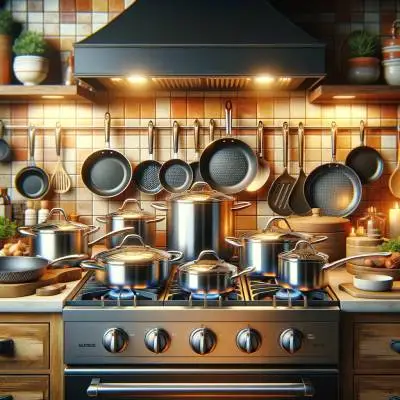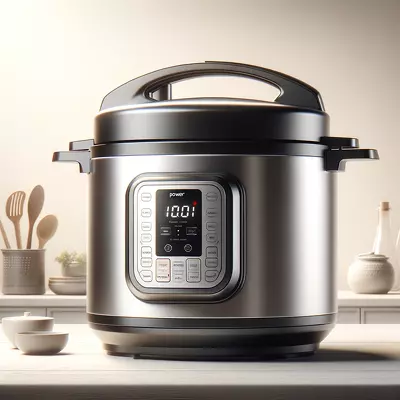Mastering Gas Stove Gourmet: The Ultimate Guide to the Best Pots and Pans
Selecting the right cookware can transform your culinary experience, especially when using a gas stove. Understanding the nuances of heat distribution and material compatibility is essential for achieving consistent cooking results. This guide offers insights into the top choices for pots and pans, ensuring your dishes are cooked to perfection every time.
As an Amazon Associate, we earn a commission from qualifying purchases.
I. Introduction
A. Importance of Suitable Cookware for Gas Stoves
The choice of cookware is pivotal in mastering the art of cooking, especially on a gas stove. Gas stoves are known for their precise temperature control and even heat distribution. However, to fully harness these benefits, one needs cookware that responds well to these characteristics. The right pots and pans can significantly affect the taste, texture, and nutritional value of the food, making it crucial to choose wisely.
B. Criteria for Selecting the Best Pots and Pans
Selecting the best cookware involves considering several factors. Heat conductivity, material durability, ease of maintenance, and compatibility with a gas stove are paramount. Additionally, factors like the cookware’s weight, handle comfort, and balance also play a significant role in the cooking experience. With these criteria in mind, let’s explore some of the top cookware sets suitable for gas stoves.
II. Review of Top Cookware Sets
A. Calphalon 10-Piece Nonstick Kitchen Cookware
- Features and Specifications
The Calphalon 10-piece set boasts a nonstick coating that promises both durability and easy food release. Designed with hard-anodized aluminum, this set ensures even heating without hot spots. Stay-cool stainless steel handles add to the functionality, offering a comfortable and safe grip during cooking. - Pros and Cons
Users praise the set for its robust construction and the longevity of its nonstick surface. The even heat distribution is a highlight, making it a favorite among gas stove owners. However, some users have mentioned that the cookware is a bit heavy, and special care needs to be taken to maintain the nonstick coating. - User Experiences and Ratings
Overall, the set receives high ratings for its performance and durability. The majority of users appreciate the quality of the materials and the ease of cleaning. While it’s on the pricier side, many find the investment worthwhile for the quality and longevity it offers.
B. Meythway 6-Piece Stainless Steel Nonstick Cookware
- Features and Specifications
The Meythway 6-piece set stands out with its stainless steel construction and nonstick performance. The cookware is designed to be compatible with all stovetops, including gas stoves. Its stay-cool handles are a nod to safety and comfort, while the non-toxic, dishwasher-safe materials make it a practical choice for modern kitchens. - Pros and Cons
The set is lauded for its sleek design and nonstick convenience. It requires less oil for cooking, which is a healthier choice. The heat distribution is even, ensuring well-cooked meals. However, some users note that the stainless steel requires proper maintenance to avoid discoloration and preserve its shine. - User Experiences and Ratings
Most users are satisfied with the performance, especially noting the ease of cleaning and maintenance. The cookware’s compatibility with various stovetops, including gas, makes it a versatile addition to any kitchen.
C. Duxtop 17PC Professional Stainless Steel Induction Cookware
- Features and Specifications
This comprehensive 17-piece set from Duxtop is crafted for the professional kitchen. It features impact-bonded technology, ensuring optimal heat distribution and compatibility with all cooking surfaces. The set’s heavy gauge impacted-bonded aluminum base ensures quick and even heating, perfect for the dynamic environment of a gas stove. - Pros and Cons
The extensive collection of pieces is a significant plus, offering versatility for various culinary tasks. The quality of construction is frequently praised, ensuring longevity and consistent performance. However, the set’s extensive range and professional-grade quality come with a higher price point, which may only suit some budgets. - User Experiences and Ratings
The feedback is overwhelmingly positive, with users highlighting the cookware’s durability and even cooking capabilities. The investment is deemed worthwhile by most, given the set’s comprehensive range and high performance on gas stoves.
III. Buying Guide
A. Material and Durability
When choosing cookware for gas stoves, consider materials that conduct heat well and are durable. Stainless steel, cast iron, and aluminum are popular choices. Ensure the material can withstand the direct flame and temperature variations of a gas stove.
B. Heat Conductivity and Distribution
Even heat distribution is crucial for cooking. Materials like copper and aluminum are excellent heat conductors, ensuring that food cooks evenly. However, they may require a stainless steel or other protective coating to prevent reactions with acidic foods.
C. Compatibility with Gas Stoves
Not all cookware is suitable for gas stoves. Ensure that the pots and pans you select are compatible, can handle rapid temperature changes, and are stable on the stovetop grates.
D. Ease of Cleaning and Maintenance
Consider the ease of cleaning and maintenance. Nonstick coatings can be convenient but may require special care. Stainless steel is durable and easy to clean but might need regular polishing to maintain its shine.
IV. FAQs
Q: What materials are best for gas stove cookware?
A: Stainless steel, cast iron, and heavy gauge aluminum are ideal due to their heat tolerance and even heat distribution.
Q: How should I maintain nonstick pans for a gas stove?
A: To avoid scratches, use wooden or silicone utensils, avoid high heat, and hand-wash gently instead of using a dishwasher.
Q: Can I use induction cookware on a gas stove?
A: Yes, most induction cookware can be used on gas stoves, but it’s best to check the manufacturer’s recommendations.
Q: What is the impact of cookware weight on cooking on a gas stove?
A: Heavier cookware tends to distribute heat more evenly, reducing hot spots and ensuring consistent cooking.
Q: How do I prevent my cookware from tarnishing or discoloring over the gas flame?
A: Regular cleaning and polishing for stainless steel and avoiding overheating can prevent discoloration.
Q: Is it worth investing in professional cookware sets for a home gas stove?
A: If you cook frequently or desire long-lasting quality, investing in professional cookware can enhance your cooking experience.
Q: How do the handles of cookware affect the cooking process on a gas stove?
A: The handles should stay cool for safety and comfort, with a secure grip so that the cookware can be easily managed on the stove.
V. Conclusion
A. Best Offer
Duxtop 17PC Professional Stainless Steel Induction Cookware is the recommended product for its comprehensive range, superior heat distribution, and durability, making it an excellent long-term investment for gas stove cooking.
B. The Alternative
For those seeking a balance between quality and affordability, the Calphalon 10-piece Nonstick Kitchen Cookware offers robust construction, even heat distribution, and user-friendly features, making it a great choice for everyday cooking.
VI. Suggested Readings
Before diving into your next culinary adventure, enrich your knowledge with these insightful reads. Whether you’re a novice cook or a seasoned chef, these books offer valuable tips, techniques, and recipes to enhance your cooking journey.
- “Cooking for Geeks: Real Science, Great Cooks, and Good Food” by Jeff Potter – A unique blend of science and cooking, offering a deeper understanding of how cooking works.
- “The Science of Good Cooking” by Cook’s Illustrated – This book breaks down the science behind cooking techniques, helping you understand the ‘why’ and not just the ‘how’.
- “Salt, Fat, Acid, Heat: Mastering the Elements of Good Cooking” by Samin Nosrat – A beautifully illustrated guide to mastering the basic elements of cooking, perfect for anyone looking to improve their culinary skills.
- “The Food Lab: Better Home Cooking Through Science” by J. Kenji López-Alt – An in-depth exploration of culinary science, with practical advice and recipes to improve your everyday cooking.
After exploring these resources, you’ll be equipped not only with practical tips and delicious recipes but also with a deeper appreciation for the science and art of cooking. Whether you’re flipping through for a quick tip or diving deep into culinary science, these books are sure to ignite your passion for cooking.






